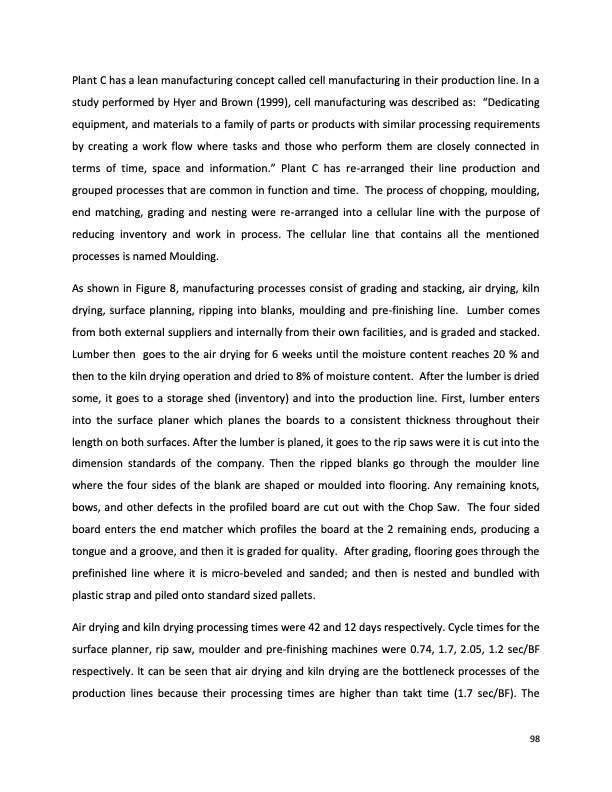
PDF Publication Title:
Text from PDF Page: 108
Plant C has a lean manufacturing concept called cell manufacturing in their production line. In a study performed by Hyer and Brown (1999), cell manufacturing was described as: “Dedicating equipment, and materials to a family of parts or products with similar processing requirements by creating a work flow where tasks and those who perform them are closely connected in terms of time, space and information.” Plant C has re-arranged their line production and grouped processes that are common in function and time. The process of chopping, moulding, end matching, grading and nesting were re-arranged into a cellular line with the purpose of reducing inventory and work in process. The cellular line that contains all the mentioned processes is named Moulding. As shown in Figure 8, manufacturing processes consist of grading and stacking, air drying, kiln drying, surface planning, ripping into blanks, moulding and pre-finishing line. Lumber comes from both external suppliers and internally from their own facilities, and is graded and stacked. Lumber then goes to the air drying for 6 weeks until the moisture content reaches 20 % and then to the kiln drying operation and dried to 8% of moisture content. After the lumber is dried some, it goes to a storage shed (inventory) and into the production line. First, lumber enters into the surface planer which planes the boards to a consistent thickness throughout their length on both surfaces. After the lumber is planed, it goes to the rip saws were it is cut into the dimension standards of the company. Then the ripped blanks go through the moulder line where the four sides of the blank are shaped or moulded into flooring. Any remaining knots, bows, and other defects in the profiled board are cut out with the Chop Saw. The four sided board enters the end matcher which profiles the board at the 2 remaining ends, producing a tongue and a groove, and then it is graded for quality. After grading, flooring goes through the prefinished line where it is micro-beveled and sanded; and then is nested and bundled with plastic strap and piled onto standard sized pallets. Air drying and kiln drying processing times were 42 and 12 days respectively. Cycle times for the surface planner, rip saw, moulder and pre-finishing machines were 0.74, 1.7, 2.05, 1.2 sec/BF respectively. It can be seen that air drying and kiln drying are the bottleneck processes of the production lines because their processing times are higher than takt time (1.7 sec/BF). The 98PDF Image | Impact of Vacuum-Drying on Efficiency of Hardwood Products

PDF Search Title:
Impact of Vacuum-Drying on Efficiency of Hardwood ProductsOriginal File Name Searched:
Brenes_Angulo_OM_T_2014.pdfDIY PDF Search: Google It | Yahoo | Bing
5,000 BF Shipping Container Lumber Dry Kiln For Quality Lumber The 5,000 BF container kiln consists of one 40 foot high-cube aluminum shipping container... More Info
Shipping Container Lumber Dry Kilns by Global Energy Global Energy designed and developed the container kiln back in 1991. The purpose is to give access to portable sawmill owners, furniture makers, and small business the value added profit of dry kiln lumber and quality hardwoods... More Info
Vacuum Kiln Conversion Kit for Lumber and Wood Dry Kilns Convert your existing conventional dry kiln into a fast drying vacuum kiln. Similar to vacuum bagging in the boat building and aircraft industry, we have come up with a proprietary process which allows you to build a very simple vacuum kiln at a fraction of the price, and without the intensive conventional metal chamber structure... More Info
Vacuum Pump Cart System for Bagging Clamping Wood Drying and more Vacuum Cart with 2HP Pump and Dual Pistons with multiple multiplex vacuum ports and liquid reservoir... More Info
Vacuum Bagging Basics Vacuum bagging is a method of clamping, which has traditionally been used in the composites industry, but can also be used for vacuum drying materials, including wood products... More Info
| CONTACT TEL: 608-238-6001 Email: greg@globalmicroturbine.com | RSS | AMP |